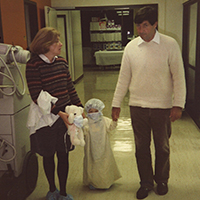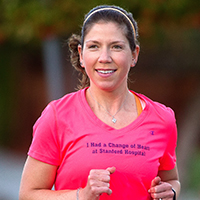Stanford Heart Transplant Recipient Celebrates Historic 30-Year Anniversary
The Bay Area’s Lizzy Craze is America’s longest-living pediatric heart transplant recipient to survive with an original donor heart.
For Release: October 6, 2014
STANFORD, Calif. – This Wednesday, Oct. 8, newlywed Lizzy Craze, 32, will go to work at her customer service job in the Silicon Valley. Then, she’ll probably squeeze in a run and have a nice dinner. Pretty normal stuff. But to those who know her, it won’t be just another day. Instead, it will mark the 30th anniversary of her heart transplant at Stanford in 1984.
The day represents a milestone in the history of pediatric heart transplantation. That’s because Lizzy hasn’t needed replacement of the donor heart during the 30 years it’s been beating in her chest. She is the only heart transplant recipient in America, and likely the world, to survive 30 years with the same donor heart she received as a toddler.
“In 1984, I was only expected to survive with my new heart for five to 10 years,” said Lizzy, whose family lost three children to familial dilated cardiomyopathy and whose surviving older brother also had a heart transplant.
1984 was a landmark year for pediatric heart transplantation. Though transplants had been performed in older children, that year marked the first series of small-child (under the age of 5) heart transplants at a handful of transplant centers, such as Stanford and Columbia. It was groundbreaking territory.
“No one was sure back then if a donor heart would even grow if you put it in such a young child,” said cardiologist Daniel Bernstein, MD, who guided Lizzy’s care throughout childhood at Lucile Packard Children’s Hospital Stanford and the Heart Transplant program.
The surgery, which some considered experimental, came at a dramatic moment. Lizzy was a few months shy of her third birthday when her heart was failing fast. A transplant was her only option.

She could not have been in better hands. The trailblazing surgery was led by the late Norman Shumway, MD, the father of American heart transplantation, who performed the first successful adult heart transplant in the United States in 1968 at Stanford. On Shumway’s team was Philip Oyer, MD, who is still active as a professor of cardiothoracic surgery at the Stanford University School of Medicine.
Lizzy was the youngest successful heart transplant recipient in America at the time of her transplant.
But many doctors assumed her new heart would need replacing at some point. Transplanted hearts can fail due to organ rejection or other complications; the other small children who received donor hearts in 1984 either died or eventually required another heart transplant.
Bernstein said he and his team “had to do a lot of never-done-before tricks to manage Lizzy’s transplant. We even borrowed some techniques the kidney transplant doctors used. For example, we treated Lizzy every other day with steroids so she would grow. We also used the immunosuppressant cyclosporine, which had just been introduced. Later, as we learned more, we discovered that if you get past 10 years, your chance of living a long time with your originally transplanted heart increases. The body’s immune system adapts to the new heart better.” (Lizzy needed a kidney transplant as a teenager due to the side effects of anti-rejection medicines.)
It hasn’t hurt that Lizzy has been a model patient. “I know the importance of taking my medications and being physically active,” she said. True that – her boyfriend and now husband, Jeff, proposed while they were backpacking in Yosemite last year, and on Oct. 5 she completed the Rock’n’Roll Half-Marathon in San Jose.
But living 30 years with the originally transplanted heart? No one could have predicted the milestone. “I think this case is a monument to what we still don’t understand in the field of biology,” said Bernstein, who is also a professor of pediatrics at the School of Medicine.

When she turned 18, Lizzy “graduated” from Lucile Packard Children’s Hospital to the adult heart transplant program at Stanford. “That transition to a different care team can be difficult,” said Sharon Hunt, MD, medical director of the Post-Heart Transplant Program at Stanford Health Care, “and we put forth a major effort to make it as smooth as possible. In Lizzy’s case, this was easy because she’s such an ideal patient.” Hunt, professor of cardiovascular medicine at the School of Medicine, was at Stanford when the groundbreaking transplant occurred. “I’ve been able to watch her career and personal development, and it’s been fun.”
“Her story is truly inspiring,” said Mary Burge, LCSW, a social worker at Stanford since 1980. Burge was there to help support parents Susan and Charles Craze when Lizzy had her transplant, and also in 1983 when Lizzy’s 16-year-old brother had his heart transplant. Burge still works with patients at Lucile Packard Children’s Hospital. “When meeting new families who are devastated to learn their child will die without a transplant, they’re encouraged by the positive way Lizzy lives her life. And when I share photos of Lizzy, they see that’s she’s not shy about showing her scar. The pride and joy with which Lizzy lives her life provides tremendous hope for others.”
Through it all, Lizzy and her family have never forgotten the power of organ donation. “We are always
mindful that, during a time of unbelievable grief, the family of a stranger gave me the gift of life,” said Lizzy. “We are forever thankful.”
Lizzy pays it forward. She is a member of the Transplant Patient Advisory Council at Stanford Health Care and keeps track of heart transplant stories and patients around the world. “I think it’s great for other heart transplant recipients to know that, like me, you can live a totally normal and long life,” said Lizzy, who honeymooned in Africa this year. And in celebration of her anniversary, she is raising money and awareness for Donate Life California.
But even though Lizzy has reached Wikipedia fame, she’s still taking the anniversary in stride. There really are no big plans for Oct. 8. Of course, if you see her out for her regular run that day, she’ll be easy to spot. That’s because she’ll be wearing the custom T-shirt she displayed at the San Jose half-marathon. On the front? It reads, I had a change of heart at Stanford. On the back, heart transplant recipient 1984.
Only one person can wear that shirt.
Authors
Media Contact:
Robert Dicks
(650) 497-8364
rdicks@stanfordchildrens.org
About Stanford Medicine Children's Health
Stanford Medicine Children’s Health, with Lucile Packard Children’s Hospital Stanford at its center, is the Bay Area’s largest health care system exclusively dedicated to children and expectant mothers. Our network of care includes more than 65 locations across Northern California and more than 85 locations in the U.S. Western region. Along with Stanford Health Care and the Stanford School of Medicine, we are part of Stanford Medicine, an ecosystem harnessing the potential of biomedicine through collaborative research, education, and clinical care to improve health outcomes around the world. We are a nonprofit organization committed to supporting the community through meaningful outreach programs and services and providing necessary medical care to families, regardless of their ability to pay. Discover more at stanfordchildrens.org.
Connect with us:
Download our App: